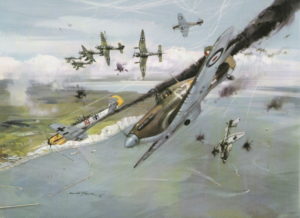1940
The Hardest Day
By the summer of 1940 Hitler and his allies controlled all of western and central Europe. Britain stood alone against complete Nazi victory, but its army had retreated from France leaving all its weaponry and transport behind; the only fully-equipped force was a single Canadian division. Should German troops land in Britain, there was little to stop them occupying the whole of the island. Operation Sea-Lion was the German plan to cross the English Channel but first it had to clear the waters of the Royal Navy and the skies of the Royal Air Force.
The Luftwaffe outnumbered the RAF and its veteran fliers had gained experience and confidence in crushing the airforces of Poland France. The German General Staff believed that by attacking English air bases they could force the RAF into battle and destroy its supply of fighter and pilots. Without air cover the British would either be forced to negotiate or stand open to invasion. The attacks began in June, with Hitler demanding a resolution of the situation by mid-August. The Heinkels, Dorniers, Stukas, and Messerschmitts were met by Hurricanes, Spitfires and Defiants over southern England and the Channel.
August 18 is known as the Hardest Day because on this date because the Germans concentrated their attack on a few important bases and the resulting air battles claimed more aircraft and lives than any other single day. Both sides at the time underestimated their losses and exaggerated the damage inflicted on their enemy but it appears that the RAF lost 34 fighter craft and 21 pilots killed or seriously wounded. The Luftwaffe lost 70 planes with 90 crewmen killed and 40 captured. The result was a stategic draw. One historian’s verdict was:
The laurels for the day’s action went to the defenders. The aim of the Luftwaffe was to wear down the Fighter Command without suffering excessive losses in the process, and in this it had failed. It cost the attackers five aircrew killed, wounded, or taken prisoner, for each British pilot casualty. In terms of aircraft, it had cost the Luftwaffe five bombers and fighters for every three Spitfires and Hurricanes destroyed in the air or on the ground. If the battle continued at this rate the Luftwaffe would wreck Fighter Command, but it would come close to wrecking itself in the process
